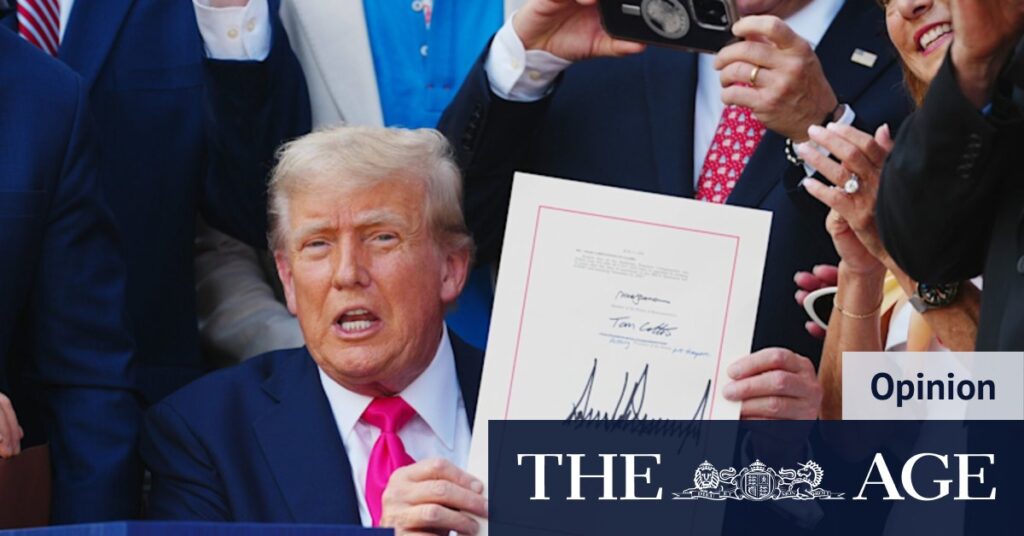
The United States, once a beacon of technological innovation, is facing significant challenges in maintaining its supremacy in 21st-century technologies. The burgeoning clean energy and cleantech sectors, which had been gaining momentum before Donald Trump’s return to office, are now under threat. This development also jeopardizes the leadership role of Nvidia, a key player in the semiconductor industry, which is crucial for America’s artificial intelligence (AI) advancements.
Nvidia, the most valuable company on the U.S. stock market, is at the heart of America’s AI revolution with its sophisticated semiconductors. However, the lack of access to affordable energy could drive data centers, a major consumer of Nvidia’s chips, to relocate to regions like the Middle East, where countries are aggressively courting U.S. tech firms with promises of solar-powered facilities.
Trade Wars and Tariffs: A Double-Edged Sword
The Trump administration’s penchant for trade wars and tariffs is exacerbating the situation. These policies are increasing operational costs for U.S. tech companies and constraining the supply of essential components. Even the oil and gas sector, which has been encouraged to expand by the administration, is feeling the pinch. Tariffs on steel, aluminum, and copper are driving up costs, potentially leading to reduced production.
Key players in the U.S. semiconductor supply chain, including Taiwan, Japan, and South Korea, are also affected. Taiwan, responsible for manufacturing most of Nvidia’s advanced chips, faces the threat of a 32% tariff. Meanwhile, Japan and South Korea have been warned of 25% tariffs, separate from those on their automotive and steel exports to the U.S.
Economic Implications of Policy Decisions
The combination of Trump’s tariffs and the “One Big Beautiful Bill” could transform America into a higher-cost economy more reliant on fossil fuels. This shift is occurring despite the gas sector’s limited capacity to support the potential growth of the U.S. AI industry. Elon Musk, a vocal critic of the bill, has warned of its destructive potential, stating it could cost millions of American jobs and harm strategic industries.
“Utterly insane and destructive. It gives handouts to industries of the past while severely damaging industries of the future,” Musk posted on X earlier this month.
China’s Technological Ascendancy
While America appears to be retreating in terms of energy and trade policies, China is forging ahead with its technological ambitions. The country has emerged as a leader in renewable energy, driven by a decade-long pursuit of energy independence and a reduction in reliance on imported oil and gas. This strategy has positioned China at the forefront of solar panel, wind turbine, and battery production, as well as the global supply chains for these technologies.
China’s success in renewables has spurred advancements in electric vehicles (EVs) and the electrification of its transportation networks. This year alone, China has produced 45% more EVs. Although it continues to add coal-fired power to its grid, nearly a third of its electricity now comes from solar, wind, and hydro sources. By the end of the decade, about half of China’s power is expected to be generated from low-carbon sources.
Future Prospects and Strategic Implications
The scale of China’s renewable sector and the intense competition among domestic companies have led to continuous innovation and cost reductions. Despite challenges such as over-capacity in solar panel and EV manufacturing, China is well-positioned to lead the next phase of the global economy. Its lower energy costs and higher degree of electrification offer a significant advantage over the U.S.
As demonstrated by DeepSeek’s cheaper version of ChatGPT, China is also capable of challenging America’s dominance in advanced chip technologies. The cooperation of America’s allies, prior to Trump’s tariff-based economic conflicts, is crucial in this context. However, Trump’s policies have curtailed efforts to re-engage in the technology race, leaving America at a potential disadvantage.
In conclusion, America’s current policy trajectory may inadvertently cede competitive ground to China in industries critical to future economic and geopolitical leadership. As the U.S. grapples with higher electricity and manufacturing input costs, China continues to advance its electrification and manufacturing strategies, positioning itself as the dominant low-carbon economy of the 21st century.







